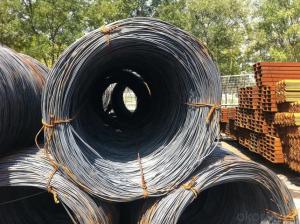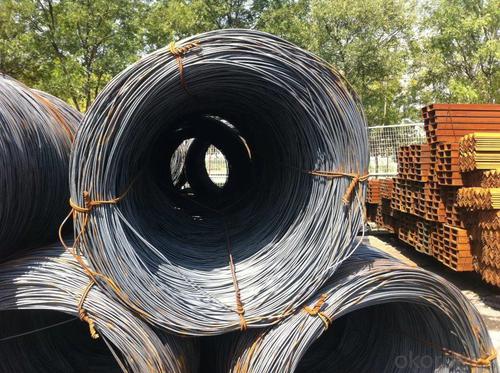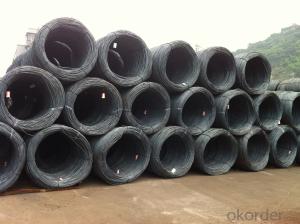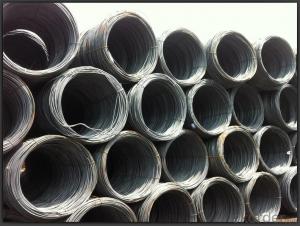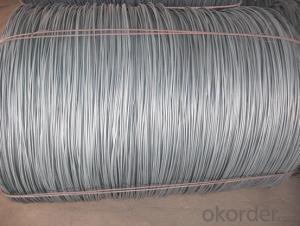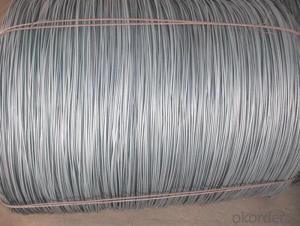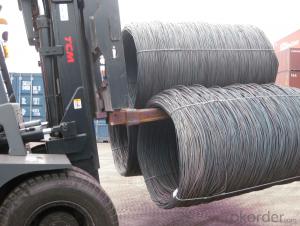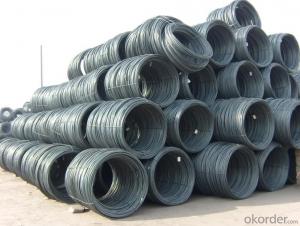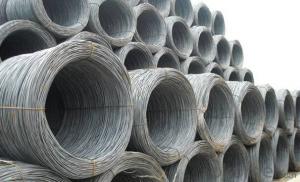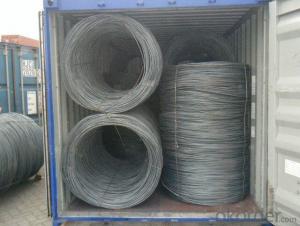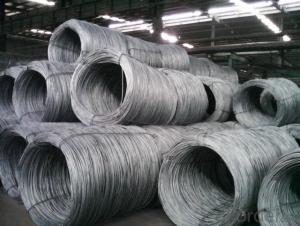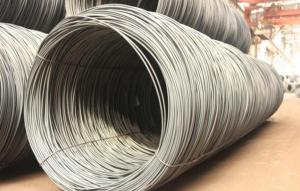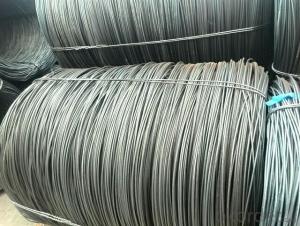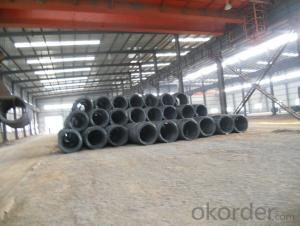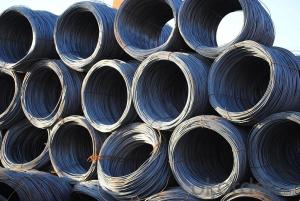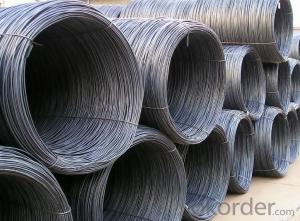SAE 1008B Wire Rod 10mm
- Loading Port:
- China Main Port
- Payment Terms:
- TT OR LC
- Min Order Qty:
- -
- Supply Capability:
- -
OKorder Service Pledge
OKorder Financial Service
You Might Also Like
Specifications of Steel Wire Rod in Coil:
Steel Grade: Q195/235, SAE1006-1018B Standard: ASTM, GB
Diameter: 6.5mm
Type: Drawn Wire Alloy or Not: Alloy
Technique: Hot Rolled
Usage and Applications of Hot Rolled Wire Rod:
After hotrolled the products shaped into coil and delivery as finished product, including round, square, rectangular, hexagonal and so on. Since most of the products are round, it is generally called wire rod. Carbon steel wire rod is widely used in construction and manufacturing. Carbon steel wire rod is mainly used for reinforcement of reinforced concrete and welded structure or reprocessed (roberts , nail, etc.) materials, especially used to produce wire drawing, welding electrode, nails, spring, electronic, precise machinery parts and so on.
Packaging & Delivery of Hot Rolled Wire Rod:
Packaging Detail: products are packed in coil, each coil weight around 2 MT, and then shipped by container or bulk vessel
Delivery Detail: within 45 days after received deposit or LC.
Label: to be specified by customer, generally, each bundle has 1-2 labels
Trade terms: FOB, CFR, CIF
Note:
1. Our products are produced according to national standard (GB), if not, supply according to national standards (GB) or agreement as customer required.
2. Other Grade and Standard carbon steel wire rod we can supply:
Grade: H08A, 30MnSi, 62B-82B
Standard: AISI, BS, JIS, DIN
The Minimum Order Quantity of these products is high, and need to be confirmed.
3. We can not only supply carbon steel wire rod; if you need anything about building materials, please contact us.
4. Please send us your detail specifications when inquire. We will reply to you as soon as possible. We sincerely hope we can establish a long stable business relationship.
- Q: How is steel wire rod used in the manufacturing of wire for oil and gas pipelines?
- Steel wire rod is a crucial component in the manufacturing of wire for oil and gas pipelines. It is first processed into wire through various steps such as hot rolling, cold drawing, and coating. This wire is then further processed and turned into strands or cables that are used to reinforce the pipelines, providing strength and durability. The steel wire rod's high tensile strength and corrosion resistance make it an ideal material for withstanding the harsh conditions of oil and gas pipelines, ensuring their safe and efficient operation.
- Q: What are the typical dimensions of steel wire rod?
- The typical dimensions of steel wire rod vary depending on the specific application and industry requirements. However, common dimensions range from 5.5mm to 14mm in diameter.
- Q: What are the transportation options for steel wire rod?
- The transportation options for steel wire rods include trucking, rail, and shipping.
- Q: What are the common production processes for tool steel wire rod?
- The common production processes for tool steel wire rod include melting and refining the steel, followed by continuous casting to form the wire rod. The rod is then hot rolled to achieve the desired size and shape, followed by heat treatment processes such as annealing, quenching, and tempering to enhance its strength and hardness. Finally, the wire rod may undergo surface treatments like drawing, coating, or polishing before it is ready for use in tool steel applications.
- Q: What are the main factors influencing the choice of steel wire rod packaging?
- The main factors influencing the choice of steel wire rod packaging include the requirements for protection, transportation, handling, and storage of the product. One of the key factors is the need for protection. Steel wire rods are prone to damage from various external factors such as moisture, dirt, and corrosion. Therefore, the packaging must provide adequate protection against these elements to ensure the quality and integrity of the product. This may involve using materials that are moisture-resistant, such as plastic or coated paper, and implementing measures to prevent rust and corrosion, such as applying anti-corrosion coatings. Transportation considerations also play a crucial role in determining the packaging choice. Steel wire rods are often transported over long distances, either by road, rail, or sea. The packaging should be sturdy enough to withstand the rigors of transportation, including potential impacts and vibrations. It should also be designed in a way that facilitates easy loading and unloading, and minimizes the risk of damage during handling and transportation. The storage requirements of steel wire rods also influence the packaging choice. Depending on the storage conditions, such as indoor or outdoor storage, the packaging may need to offer additional protection against factors like sunlight, extreme temperatures, and humidity. It should also be stackable to optimize space utilization and prevent any deformation or bending of the wire rods. Other factors that may influence the choice of steel wire rod packaging include cost-effectiveness, sustainability, and regulatory compliance. Companies may consider the cost of the packaging material, its availability, and the overall packaging process to ensure that it aligns with their budget and operational efficiency. Moreover, there is an increasing focus on sustainable packaging solutions that minimize environmental impact, such as using recyclable materials or reducing the overall packaging waste. Compliance with industry standards and regulations, such as safety and labeling requirements, is also a significant consideration in the choice of steel wire rod packaging.
- Q: How is the bending properties of steel wire rod tested?
- The bending properties of steel wire rod can be tested by subjecting it to a bending test, where the rod is bent to a specified angle and checked for any signs of cracking, deformation, or failure. This test helps determine the flexibility and strength of the wire rod under bending forces.
- Q: How is steel wire rod used in the production of wire mesh for automotive applications?
- Steel wire rod is used in the production of wire mesh for automotive applications by being drawn through a series of dies to reduce its diameter and increase its length. This process, known as wire drawing, results in a thin and elongated wire that is then woven or welded to create wire mesh. The wire mesh is then utilized in various automotive applications such as reinforcing structures, providing protection, or acting as a filtration system.
- Q: How does steel wire rod compare to other materials for wire production?
- Steel wire rod is widely regarded as one of the most suitable materials for wire production due to its exceptional strength, durability, and versatility. Compared to other materials, such as aluminum or copper, steel wire rod offers superior tensile strength and resistance to corrosion, making it ideal for various applications. Additionally, steel wire rod can be easily shaped, welded, and drawn into different wire sizes and forms, ensuring its compatibility with diverse industries like construction, automotive, and manufacturing. Its cost-effectiveness and widespread availability further contribute to its preference over other materials in wire production.
- Q: What are the potential applications of stainless steel wire rod?
- The unique properties and versatility of stainless steel wire rod make it suitable for a wide range of applications. Some of these applications include: 1. Construction and infrastructure: Stainless steel wire rod is often used in construction and infrastructure projects due to its strength, durability, and resistance to corrosion. It can be utilized in the production of reinforcement bars, concrete structures, bridges, and other crucial infrastructure components. 2. Automotive industry: Stainless steel wire rod is employed in the manufacturing of different automotive components, such as exhaust systems, suspension springs, and engine parts. Its excellent resistance to heat, corrosion, and high temperatures makes it ideal for demanding automotive applications. 3. Aerospace industry: The lightweight nature and high strength-to-weight ratio of stainless steel wire rod make it suitable for the aerospace industry. It is used in the production of aircraft components, including fasteners, cables, and structural elements, where corrosion resistance and mechanical properties are vital. 4. Medical equipment: Stainless steel wire rod is widely used in the production of medical equipment and instruments due to its biocompatibility, corrosion resistance, and ease of sterilization. Surgical tools, implants, orthodontic wires, and other medical devices are made using stainless steel wire rod. 5. Power generation: The power generation industry utilizes stainless steel wire rod for its excellent resistance to high temperatures, pressure, and corrosion. It is commonly used in the production of turbine blades, heat exchangers, and other critical components in power plants. 6. Food processing industry: Stainless steel wire rod is extensively used in the food processing industry because of its hygienic properties and resistance to corrosion. It is employed in the production of food handling equipment, storage tanks, and processing machinery. 7. Wire products: Various wire products, such as springs, wire mesh, cables, and fencing, are made using stainless steel wire rod. Its high tensile strength, corrosion resistance, and flexibility make it suitable for these applications. 8. Marine industry: The marine industry relies on stainless steel wire rod for its resistance to corrosion in saltwater environments. It is used in the production of marine equipment, boat fittings, rigging, and other components. In conclusion, stainless steel wire rod has vast and diverse potential applications, spanning across industries such as construction, automotive, aerospace, medical, power generation, food processing, wire products, and the marine sector. Its exceptional properties make it a reliable and preferred material for critical applications that require strength, durability, and corrosion resistance.
- Q: What is the typical chemical composition of steel wire rod?
- The typical chemical composition of steel wire rod consists primarily of iron, carbon, and small amounts of other elements such as manganese, silicon, and sulfur.
Send your message to us
SAE 1008B Wire Rod 10mm
- Loading Port:
- China Main Port
- Payment Terms:
- TT OR LC
- Min Order Qty:
- -
- Supply Capability:
- -
OKorder Service Pledge
OKorder Financial Service
Similar products
Hot products
Hot Searches
Related keywords
